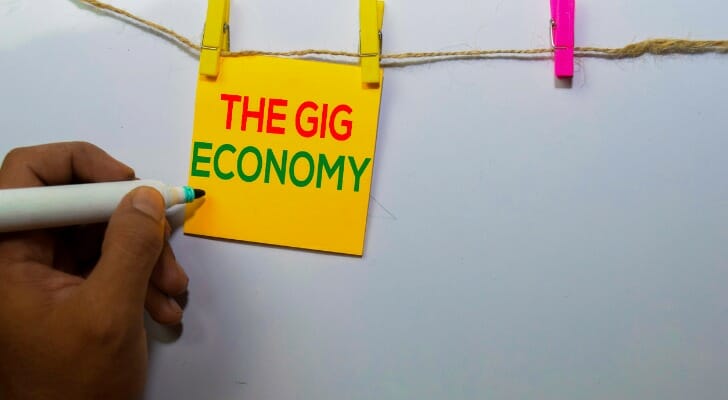 Ordinarily, only salaried employees who lose their jobs through no fault of their own are eligible to collect unemployment insurance. But the $2 trillion Coronavirus Aid, Relief, and Economic Security Act (CARES) Act expanded unemployment benefits to self-employed workers unemployed or underemployed because of the COVID-19 pandemic. Additionally, some SBA loan programs, including the new PPP loans, may be available to self-employed workers. Here’s how these benefits work.
Ordinarily, only salaried employees who lose their jobs through no fault of their own are eligible to collect unemployment insurance. But the $2 trillion Coronavirus Aid, Relief, and Economic Security Act (CARES) Act expanded unemployment benefits to self-employed workers unemployed or underemployed because of the COVID-19 pandemic. Additionally, some SBA loan programs, including the new PPP loans, may be available to self-employed workers. Here’s how these benefits work.
Unemployment for the Self-Employed
Under normal circumstances, only full-time workers are eligible for unemployment if they lose their jobs. These workers’ employers withhold taxes from their paychecks that fund unemployment insurance programs. Non-traditional employees – including independent contractors, freelancers and gig workers – don’t contribute to unemployment insurance through withholding, so they don’t receive those unemployment benefits.
The Coronavirus Aid, Relief, and Economic Security (CARES) Act changed that. The bill contains a range of provisions intended to ease the economic fallout of the COVID-19 pandemic, including expansion of unemployment benefits. Specifically, it extends these benefits to “non-traditional” workers including:
- Sole proprietors
- Independent contractors
- Freelancers
- 1099 workers
- Gig workers
- Ride-sharing drivers
Essentially, people who have never qualified for unemployment benefits now can. Section 2102 of the legislation specifically provides for people who are self-employed or seeking part-time employment; aren’t eligible for unemployment benefits and are unemployed; partially unemployed; or unable to work because of health or economic consequences of the pandemic.
Pandemic Unemployment Assistance
 Pandemic Unemployment Assistance (PUA) is the CARES Act program that specifically addresses non-traditional workers. PUA provides for up to 39 weeks of weekly benefits. Those eligible for it include people who:
Pandemic Unemployment Assistance (PUA) is the CARES Act program that specifically addresses non-traditional workers. PUA provides for up to 39 weeks of weekly benefits. Those eligible for it include people who:
- Are not eligible for normal state unemployment benefits
- Are unemployed, under-employed or unable or unavailable to work due to COVID-19
- Are self-employed, seeking part-time work or lack sufficient work history
- In some states, clergy and people working for religious institutions
The period of under- or unemployment must have begun on or after Jan. 27, 2020. Benefits are retroactive for periods of unemployment back to that date. However, benefits can’t be paid for unemployment after Dec. 31, 2020.
It’s still important that people be unemployed through a lack of available work. They can’t have left their job voluntarily. This includes quitting a job out of fear of contracting the virus. Generally, if an employer remains open and the applicant can come to work, they won’t qualify for PUA benefits.
There are several exclusions to this general rule, including someone who can’t come to work because:
- He or she is ill with the virus
- Someone in the household has been diagnosed with COVID-19
- A child is home because school is closed
- A healthcare professional advised a COVID-19 quarantine or self-quarantine
Workers who can be paid for teleworking or who are getting sick-leave benefits would not qualify for PUA. Most states also require that the recipients have worked four out of the last five quarters.
Applicants can self-certify that they meet the requirements. However, fraud or intentional misstatements can be prosecuted under federal law.
The amount of the weekly PUA payment is equal to the benefit that would be provided by function of the state unemployment insurance program.
Pandemic Emergency Unemployment Compensation (PEUC)
The PUEC section of the CARES Act provides for an extra $600 a week to be paid out on top of the regular state unemployment insurance benefit amount. The PUEC benefit increase applies to anyone who is receiving unemployment benefits. It’s not just for self-employed and gig workers covered by PUA.
PUEC benefits can be paid for no more than 13 weeks. And they cover periods of unemployment up to July 31, 2020.
How to Apply
 The CARES Act is federal legislation, but people seeking benefits under it must apply to their state unemployment agencies. The U.S. Department of Labor has an online directory to state agencies here. Applicants can file in person, over the phone or online, depending on the state.
The CARES Act is federal legislation, but people seeking benefits under it must apply to their state unemployment agencies. The U.S. Department of Labor has an online directory to state agencies here. Applicants can file in person, over the phone or online, depending on the state.
The speed with which the legislation was drafted and enacted has left state agencies scrambling to handle the volume of applicants. To help cope with the backlog, some states are setting aside specific days for applicants whose names begin with specific letters of the alphabet.
Some states have begun making payments. However, others are still getting the program rolled out and have yet to make any payments.
Benefits are paid retroactively. So successful applicants will receive benefits as of the date of their unemployment, not the date they are approved.
Applicants should be ready to supply the following information and paperwork when applying:
- Personal information, including name and address
- Social Security number
- Tax return or 1099 form to verify income
- If not self-employed but still covered, such as church employees, workers will need pay stubs or W-2 forms.
If approved for benefits, workers will have to re-certify weekly that they are unemployed. And if their work re-opens or other restriction keeping them from working is lifted, they are expected to return to work and stop receiving benefits.
Paycheck Protection Program
The $2 trillion CARES Act also made benefits under the Paycheck Protection Program (PPP) available to the self-employed. The government designated $349 billion for the PPP as an SBA 7(a) loan, which can be forgiven. The loans feature a streamlined application process, less documentation and comparatively few restrictions.
However, by April 16 that $349 billion had been spoken after the SBA approved more than 1.6 million loan applications. The SBA stated on its website that it is “currently unable to accept new applications for the Paycheck Protection Program based on available appropriations funding.” Congress may appropriate more money for the program. If or when it does, you should know the following about PPP provisions for the self-employed.
Who may apply
PPP money is available for self-employed individuals, such as independent contractors or sole proprietors, who file an IRS Schedule C with their Form 1040 to report their self-employment income in 2019. These individuals can work alone or have employees. Applicants must have been in operation on Feb. 15, 2020, and have the U.S. as their principal place of residence.
Partners with self-employment income from partnerships are not eligible for PPP loans as self-employed individuals.
What the money is for
PPP money may be used for a wide variety of business expenses:
- Owner compensation, calculated off 2019 net profit
- Employee payroll costs for employees who are U.S. residents, if you have employees
- Mortgage interest payments on any business mortgage obligation on personal or real property
- Business rent and utility payments
- Interest payments on any other debts that were incurred before Feb. 15, 2020 (such amounts are not eligible for PPP loan forgiveness)
How to apply
Applications for PPP loans will technically be accepted until June 10, though as of this writing the SBA has reportedly told lenders to stop accepting applications as the program is close to running out of money. However, it’s thought that Congress will ultimately allocate more funding for the program.
The SBA has detailed instructions on how those who are self-employed should calculate the amount of money they are seeking to borrow. Borrowers can apply to any SBA-approved lender, including participating commercial banks and credit unions. A list of approved lenders can be found on the SBA website. Note that many lenders are limiting eligibility to those businesses with whom they have a pre-existing relationship, such as previous loans or a business checking account. Check out our list of participating banks and their requirements (we will continually update it).
What is eligible for forgiveness
You can apply for PPP loan forgiveness with your lender eight weeks after the loan is disbursed. Borrowed money spent on the following is eligible for forgiveness:
- Payroll costs
- Covered employee benefits
- Owner compensation replacement for eight weeks, excluding any qualified sick leave equivalent amount for which a credit is claimed under the Families First Coronavirus Response Act (FFCRA) or qualified family leave equivalent for which a credit is claimed under the FFCRA
- Interest payments on mortgage obligations on real or personal property incurred before Feb. 15, 2020
- Rent and utility payments on agreements in force before Feb. 15, 2020
What about Economic Injury Disaster Loans?
You may use PPP money to refinance an SBA EIDL loan made between Jan. 31, 2020 and April 3, 2020. Your eligibility for an PPP loan is not affected if your EIDL loan was not used for payroll costs. If your EIDL loan was used to cover your payroll costs, your PPP loan can only be used to refinance your EIDL loan. Proceeds from any advance up to $10,000 on the EIDL loan will be deducted from the amount of the PPP loan that is forgiven.
The Bottom Line
The CARES Act makes state unemployment benefits available to self-employed, freelance, independent contractor and other gig workers unemployed or underemployed by the COVID-19 pandemic. Benefits are boosted by $600 over regular state benefits, and can be claimed for up to 39 weeks.
Tips for Handling Joblessness
- Consider working with a financial advisor who can build you a solid financial plan and help you invest for the future. SmartAsset’s free tool matches you with financial advisors in your area in five minutes. If you’re ready to be matched with local advisors who will help you achieve your financial goals, get started now.
- If underemployment or unemployment related to COVID-19 has made you unable to make payments on credit card debt or a mortgage, here’s how to protect your credit score.
Photo credit: ©iStock.com/SolStock, ©iStock.com/ra2studio, ©iStock.com/syahrir maulana